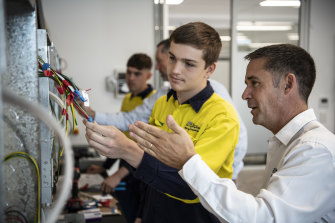The 2022-23 federal budget has some welcome funding inclusions targeting industry sectors experiencing critical skills shortages. However, the $2.8 billion funding package is set to create a significant short-term headache and is a lost opportunity to improve Australia’s pitifully low apprenticeship completion rate and provide greater value for precious taxpayer dollars.

Tom Emeleus, GM of National Electrical and Communications Association, with 1st year apprentice electrician Blake Lowe. Tom runs a group training organisation for apprentices and a training company. Credit: Wolter Peeters
Australia’s apprenticeships and traineeships support system will undergo significant changes. The current scheme, introduced in response to COVID-19, received a three-month extension in the days preceding the budget, giving employers a 50 per cent wage subsidy for first-year apprentices, 10 per cent in the second and five per cent in year three.
The newly announced Australian Apprentice Incentives System will replace these and other existing incentives from July. The new system focuses support on priority occupations determined by the National Skills Commission.
Astute apprenticeship applicants in priority sectors will realise that by delaying their commencement until July 1, they’ll collect $5,000 under the new scheme. As a result, we’re likely to see a drought in apprenticeship applicants in the coming three months, making the three-month extension to the current scheme redundant.
Don’t get me wrong, the new scheme and its inducement of apprentice applicants, in theory, makes sense. Record low unemployment has made recruiting young Australians into apprenticeships more challenging than ever. However, overnight, the transition from incentivising employers to incentivising apprentices will create a cliff in apprenticeship applications until July 1.

The new apprentice scheme announced in the Budget will not solve skills shortage issues.Credit:Louie Douvis
On top of this, the new model removes completion incentives, where employers were paid a $1,500 commencement bonus and $2,500 upon completion. Shifting to just commencement payments does nothing to fix the paltry completion rates, with only 55 per cent of trade apprentices currently finishing their training. Besides its considerable cost to taxpayers, this attrition is amplifying labour shortages. If the new scheme did more to drive better completion rates – lifting them to 85 per cent – we’d overcome skills shortages.
Furthermore, a valuable cohort of apprentices seems likely to miss out – Australian Awards covering major trades define “mature-aged” as 21 years and older at commencement. The National Electrical and Communications Association has long advocated for wage subsidies to offset the higher costs of employing mature-age apprentices. With a disproportionate representation of women, this group often decides to pursue a trade in their early 20s, commonly after a university degree has not led to the career path or the job stability they envisaged.
At 3.8 per cent, the female unemployment rate is the lowest it has been for 50 years, but this ignores the gender pay gap, underemployment and the fact that females represent only two per cent of tradespeople within the electrical industry. The budget announcement of $38.6m for supporting women in targeted occupations is a very welcome initiative. Subsidising mature-aged apprentice wages would, however, support female inclusion even further.








